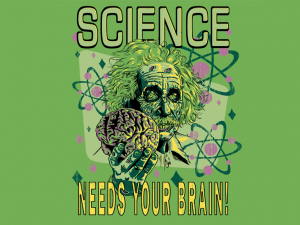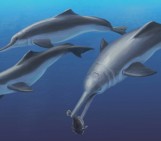Throughout this series, I have highlighted the pitfalls and issues associated with effective communication of scientific knowledge to and with the public. This has largely been fueled by a recent paper highlighting these points as stepping stones and hurdles which scientists face and can develop upon to create strategies for becoming better at public communication. However, I’ve yet to offer any kind of solution.
Yesterday, I wrote briefly about the way in which geoscientists can use different plots to help them reconstruct scientific information into a digestible narrative format, taking on the style of a refashioned ‘story’. Continuing to draw upon the analysis by Iain Stewart and Ted Nield, this post will focus on how developing a narrative and particular language can help researchers to ‘talk geoscience’ in a more engaging manner.
To reiterate the actual issue, I’m going to steal a quote from the Stewart and Nield paper citing the geoscientist and science writer Rex Buchanan (it’s like he was made to be a geoscientist with a name like that..):
“We do a mediocre job of helping adults to learn about and appreciate science. Many of the science stories that I read in newspapers or try to watch on television aren’t very engaging. Some are too long, and many seem irrelevant. Popular science often seems like castor oil – some we should take because it’s good for us, not because we want too” (2005)
I don’t think the current situation is quite as dire as this makes out. There are now small armies of dedicated ‘science communicators’ at many institutions, many scientists and learned societies are becoming increasingly involved with this, and the internet is ablaze with science blogs, both amateur and professional. The scientific community appears to be embracing the role of science communication, based on the realisation that it is actually themselves who are best placed, and probably best equipped to do so in this digital era.
The manner in which we communicate with our audiences is still a largely unresolved issue. This is partially driven by the fact that we often simply do not, and cannot know who we are communicating to, which makes the communication format increasingly challenging, and the quantitative assessment of success or impact a nightmare of entangled metrics. On the ‘supply’ side, the reasons why there is still an over-arching inability for scientists to communicate are myriad and complex. Perhaps the main barrier here, is not that science is inherently complex, but the language which science and scientists use. Anyone who reads a scientific paper will be caught up in the baffling lexicon and whirlwind of field-specific science-speak. This is natural. It takes a long time to become accustomed to the way in which scientists communicate among themselves, principally through journals. I’ve been in academia for over 5 years now, and still the geoscientific literature can be confounding at times. It’s nothing to be ashamed of – this stuff is complicated!
What we need is a standardised format based on how the fundamentals of rhetoric, linguistics, and cognitive psychology (Stewart and Nield, 2012) to organise our thoughts and allow us to express them in ways that non-specialist or non-scientific audiences may be able to interact with. Perhaps also, something that I’m sure will annoy the hell out of many scientists, is the need to admit that our language is overly technical, such that it can alienate potential audiences and act as a real barrier to public communication. I think there has never been more of a time to acknowledge this than with the impending onset of near-global open access to the scientific literature (with the UK leading the way). Simply put, what’s the point in making all of this scientific information open to the public, if they can’t read it? Access does not imply accessibility. To pull a stat from Stewart and Nield: “61% of surveyed geoscientists considered that ‘most scientists are so intellectual and immersed in their own jargon that they can’t communicate with journalists or the public.’” Most is the key word here. A majority, but not all – many scientists I know personally are skilled communicators, whether it be through blogging, podcasts, direct communications, practical demonstrations, or the use of Barbie dolls (hi Tony). The use of context can be powerful in overcoming this, by providing points of reference and using metaphors and analogy to communicate complexity in digestible ways. Background information becomes redundant through this, as the placement of information in a context which is engaging and memorable at the same time outdoes the need for a 101-style education. This is a significant difference between the way in which scientists communicate, and the demand of the public. Generally speaking, scientists want to know background details, followed by supporting information, topped off with conclusions, implications, and results. Does a non-specialist audience want to know all of this? Or just the relevance to them – the ‘so what?’ question. In this respect, the context, the relevance and real-life implications are substantially more important than the communication of every specific detail.
Language is the first step in understanding what phrases and terms to use and when. The broader challenge comes from organising these, with a theme and narrative, to fashion a story with an explicit message. I think this just comes from practice – test, learn, adapt, and throughout it all remain passionate, not-boring, and most of all have a damn good time doing it! If you can’t demonstrate that your science is fun and exciting, have fun trying to get someone else to feel that way. I’m pretty lucky being a palaeontologist, as I think this is one of the easier subjects for people to get excited about (from personal experience with random people, mostly in London). Scientists can learn a thing or two from the mass media in this respect – have a hook, a context, and a message that will resonate with people and be remembered. Go out all guns blazing, but don’t forget about the actual content in the process, and the placement of information within the bigger story.
One thing to be mindful of during all of this is the concept of ‘dumbing down’ for the audience, which is often conflated with the idea of reframing a message to suit a particular purpose or audience. This charge is often made against scientists, and that we need to become better at conveying complexity; but if this is so, then the case that scientific information is too complicated with an overly-technical language has to be dropped. It cannot be both ways. It’s not about ‘dumbing down’, but it can be about simplification, which is really just a nicer way of saying ‘we removed all the unnecessary tech-speak’, while reframing the information in a more engaging format. If you want to be blunt, this is ‘dumbing down’, but only in the same way a lecturer would give the same presentation to a class of masters students then first year undergraduates. Different audience levels require different modes of language, and this example is perfectly transferable between the scientific community and non-specialist audiences.
If all else fails, become a palaeontologist.






Mike Taylor
I read this kind of thing a lot, but I’m not sure I buy it. If you want to talk meaningfully about veterbae, you have to talk about zygapophyses. If you want to talk meaningfully about evolution, you have to talk about autapomophies. While no doubt there are instances of scientists making things sound more complicated than they are (“velocitous aerial locomotion”) I think 90% of our specialist vocabulary is there because it needs to be.
So while we can and should make an effort to simplify vocabulary when possible — I talked about the “hip bone” rather then ilium when doing the Brontomerus publicity — too much of this kind of thing quickly becomes silly.
Ah yes … surveying scientists about what they think other scientists’ failing are. Ask the same geoscientists whether they are “so intellectual and immersed in their own jargon that they can’t communicate with journalists or the public” and I bet you’d get a much smaller percentage!
tennant
Hey Mike,
You’re right – there certainly is a fine balance to tread here. I often say that the power of a word comes from it’s precision (hence why I hate things like ‘trait’ and ‘ecological niche’, but there are definitely ways of simplifying vast swathes of terminology (even zygapophyses – forward or backward-projecting elements on top of the centrum, for example, depending on which set). Autapomorphy too can be re-worded as ‘advanced characteristic’, or something similar. I’m not sure palaeontology is really a subject which suffers from this too much (compared to other aspects of geoscience anyway). Maybe.
And yeah, I agree. I still find it difficult to directly talk about what I do – the keyboard is much more user-friendly than the mouth..
Mike Taylor
This seems like a fine example of how some terms can’t be “simplified”. You suggested alternative to zygapophysis is ten words instead of one, and will still leave people scratching their heads wondering what a centrum is.
Only if you don’t care about being understood. Arguably the single most important thought revolution ever in systematics work was the recognition that the only character that are informative for phylogenetic reconstruction are those that are shared by multiple organisms because they inherited them from a common ancestor. That’s a fifteen-word term for “synapomorphy” and really can’t be compressed further without losing crucial information.
Thomas R. Holtz, Jr.
Actually, there are some short, 100-level alternative to the -morphies:
Apomorphy: derived (or advanced) character [state]
Autapomorphy: unique derived character [state]
Synapomorphy: shared derived character [state]
Plesiomorphy: primitive (or ancestral) character [state]
Symplesiomorphy: shared primitive character [state]
Homoplasy: independently derived character [state], or convergence
Reversal: convergence to the primitive state
mtb
Heh. Good point about how palaeontology seems to be inherently “cool”. And within palaeontology, dinosaurs (and trilobites) are inherently cool. 😉
I sometimes wonder how to make something like petrology or mineralogy interesting to other people. I mean, I think that it is cool (as an example, the basalt at the top of the Karoo sequence in South Africa has been chemically correlated to similar flood basalts in Botswana [which is a hell of a long way for a lava flow]), but so many people look at you with a “huh?” type of expression if you tell them it is cool.
Is this not something that should be tackled at a younger age?
And yes, jargon comes into use because it is useful, precise and quicker. Much of it is not too difficult to work out from context, or is something so specific that a general idea of what it refers to may be enough.